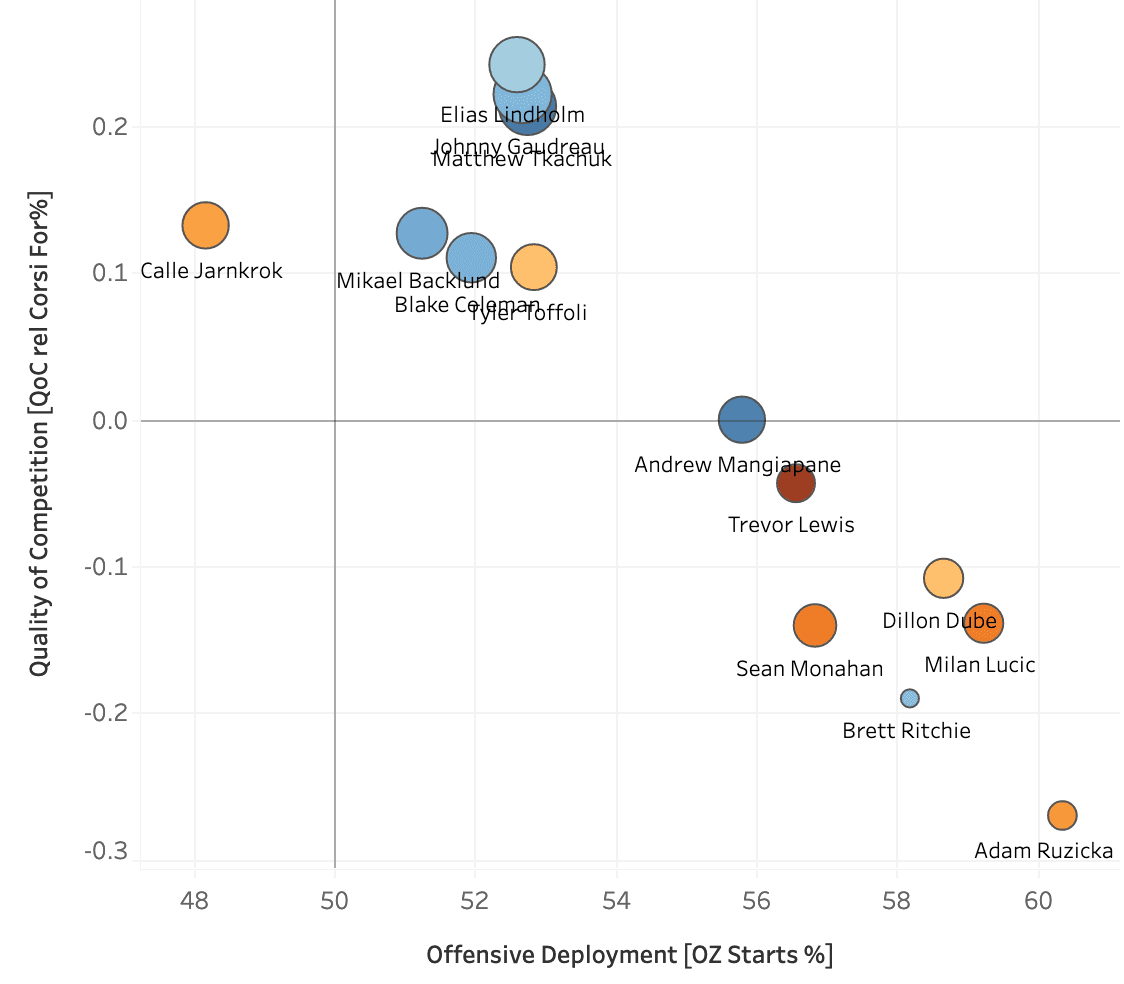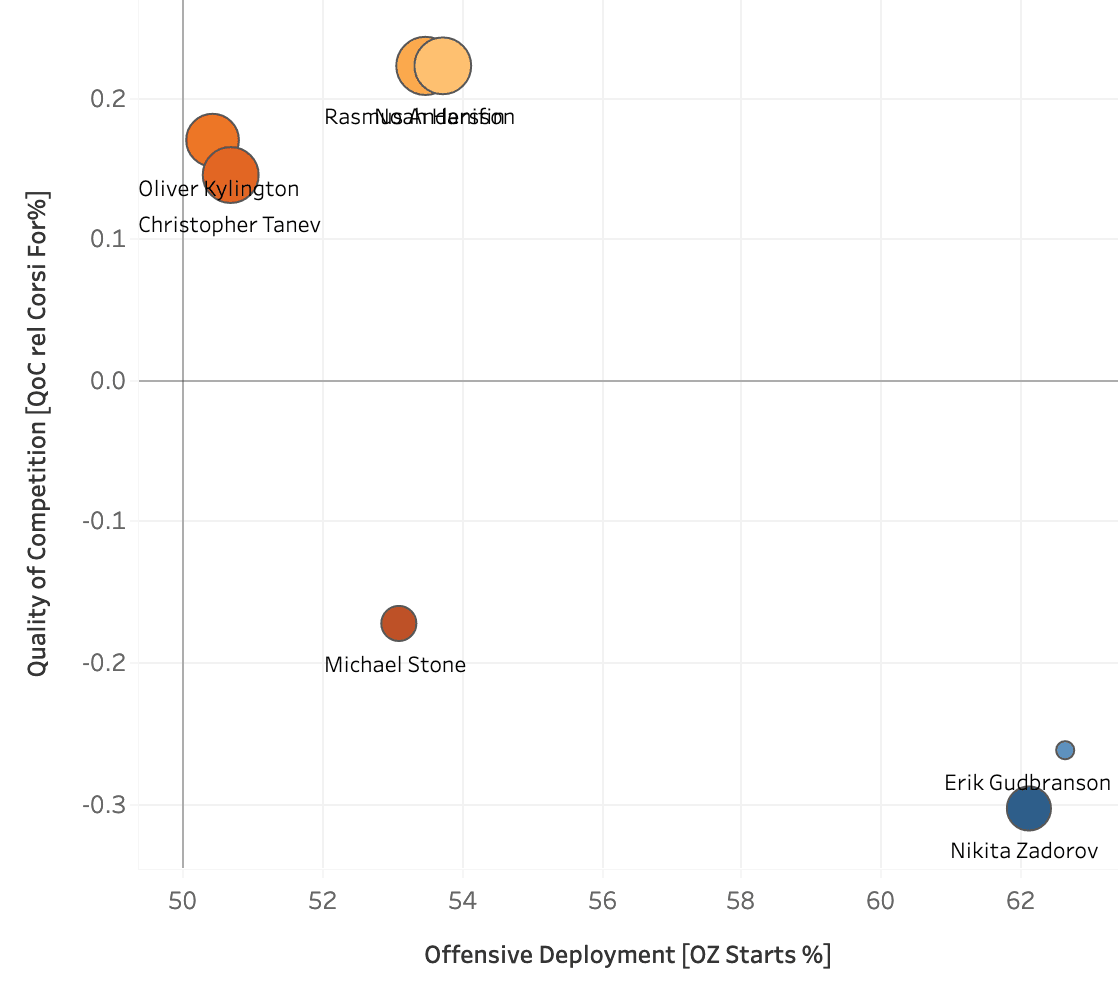Nation Sites
The Nation Network
FlamesNation has no direct affiliation to the Calgary Flames, Calgary Sports and Entertainment, NHL, or NHLPA
The Flames’ coaching staff set a strong foundation in 2021-22

Photo credit: Sergei Belski-USA TODAY Sports
The 2021-22 season was the first full season for head coach Darryl Sutter with the Flames since 2005-06. It was also Sutter’s first season with his new coaching staff, comprised of associate coach Kirk Muller, assistants Ryan Huska and Cail MacLean, and goaltending coach Jason LaBarbera.
Sutter won the Jack Adams Award as the NHL’s top coach, and his achievement was the accumulation of a bunch of smart decisions that coincided with strong performances.
Sutter had input into all aspects of the team’s game. Forwards and power play were run by Muller. Defence and penalty kill were run by Huska. LaBarbera ran goaltending. MacLean was utilized as the “eye in the sky” and informed in-game adjustments.
Forwards

Most common configuration:
- Johnny Gaudreau – Elias Lindholm – Matthew Tkachuk
- Andrew Mangiapane – Mikael Backlund – Blake Coleman
- Dillon Dube – Sean Monahan (or Calle Jarnkrok) – Tyler Toffoli (or Brett Ritchie)
- Milan Lucic – Trevor Lewis (or Adam Ruzicka) – Brad Richardson (or Lewis or Ritchie)
The Flames opted for a strength versus strength coaching philosophy for forward line deployments. Lindholm’s line got heavy offensive zone starts but primarily chased tough assignements. Backlund’s line got slightly easier assignments, while the third and fourth lines got the leftovers and more defensive zone starts.
In terms of consistency, the top two lines were pretty great, and they were kept together because they performed really well. Underneath them, the bottom six was sort of a jumble. They performed fairly well in part due to systems, but in part due to some good performances underneath – Lewis and Dube had low-key good seasons in their roles.
It would’ve been better if the bottom six had more consistent configurations and/or performed better, but the first two lines were two of the most effective in hockey. Heck, everybody on the top line received votes for major NHL awards, and Gaudreau and Tkachuk were first and second-team all-stars, respectively. The Flames’ forwards weren’t perfect, but it’s hard to really criticize how they were used too much.
Defencemen

Most common configuration:
In terms of deployments, the Flames had a clear third pairing, who got heavy defensive zone starts and faced easier opposition. The top two pairings were pretty evenly split, with Kylington/Tanev getting slightly more offensive zone starts and Hanifin/Andersson facing slightly better opposition.
All three pairings performed really well in their roles, and Michael Stone was a really effective seventh defender to slot in on occasion.
Goaltenders
Jacob Markstrom started 63 games, won 37 of them, had nine shutouts and was voted the second-best goaltender in the NHL by the general managers and the writers. That left 19 starts for young backup Dan Vladar, who won 11 of them (plus two more in relief). That’s about as much as you can ask for a goaltending tandem.
Markstrom’s entering his 30s and we can understand concern about over-working him. And yeah, as he gets deeper and deeper into his lengthy contract, it makes sense to spell him off now and then. But considering Markstrom was playing so well and Vladar had just five NHL appearances to his name prior to the season, we can give the Flames a pass on goalie utilization for this season.
Special teams
The Flames’ power play converted on 22.9% of their advantages (10th-best in the NHL). Via Natural Stat Trick, the Flames had the 5th-highest expected goals for per 60 on the power play in the NHL.
They used two main units, the first unit being a four forward/one defender group (Hanifin, Gaudreau, Tkachuk, Lindholm and Monahan or Toffoli) and the second unit being a standard three forward/two defender deployment.
The Flames’ penalty kill stopped 83.2% of opposition advantages (6th-best in the NHL). Via Natural Stat Trick, the Flames had the 2nd-lowest expected goals against per 60 on the penalty kill in the NHL.
The Flames began most kills with the same pair of forwards (Lindholm and Backlund) and the same defensive pair (Tanev and Gudbranson), and then they rotated two more forward pairs and another defensive pair through as opportunity allowed them.
Overall verdict
The Flames were not a perfect team in 2021-22. But given the players they had available to them, it’s hard to argue with the results. They were offensively potent (5th in expected goals for per 60) and defensively stingy (3rd in expected goals against per 60) at five-on-five. Their special teams were good. Their goaltending was good. They finished first in a division that included Edmonton and Vegas.
The Flames’ coaching staff did the best they could with what they had in 2021-22. The result was a regular season division banner and two playoff rounds. It might not be the ultimate goal, but it’s good for a start.
THIS ARTICLE BROUGHT TO YOU BY DAILYFACEOFF

Looking to up your fantasy hockey game? DailyFaceoff has the tools you need for both daily and season-long fantasy leagues, including a lineup optimizer, daily projections, and a whole lot more. Sign up for the DailyFaceoff tools here.
More from FlamesNation
Breaking News
- Flames Prospect Roundup: How the standings shape up entering the holiday break
- NHL Notebook: Sidney Crosby takes sole possession of most points in Penguins’ franchise history
- FlamesNation Mailbag: Waiting for Santa with reader questions
- Flames injury news: positive signs for Martin Pospisil
- Recap: Martin Frk leads Wranglers to memorable Winter Wranglerfest win in more ways than one
